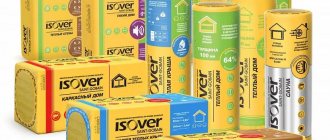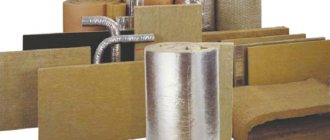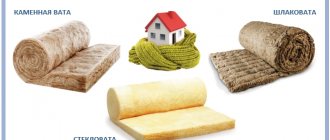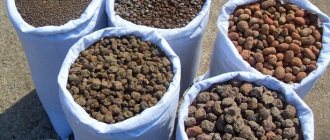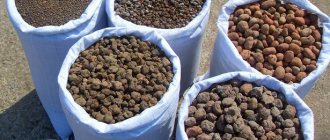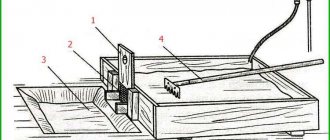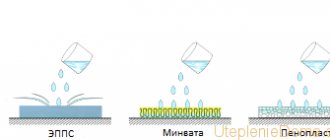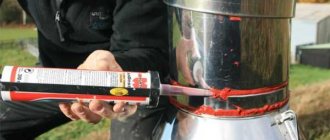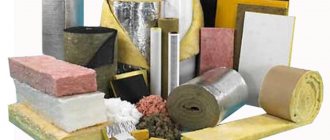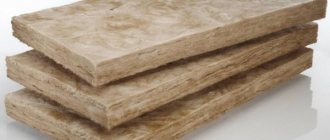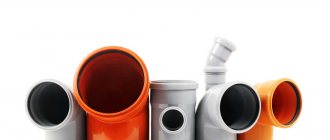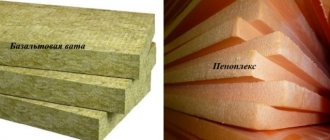Kinds
Depending on the composition, properties and scope of application, there are 3 main types of wool for sound insulation:
Material
Basalt
The material is based on basalt, which is durable. This determines the best sound and thermal insulation of the finished product, the ability to withstand heating while maintaining technical properties up to a temperature of +600 degrees.
To make basalt wool, fibers 16 mm long are used. Their diameter does not exceed 12 microns. Unlike slag and glass, this type of mineral wool is environmentally safe, it is convenient to cut, and it does not prick when used during the installation process.
Glass
Glass wool is a product of glass and limestone processing, to which sand and soda are added. The result is a strong and elastic material, which, however, has less fire resistance. The maximum heating temperature is 500 degrees. The material is very fragile and itchy. Release form: rolls.
Slag
The basis of the material is blast furnace slag, which is characterized by residual acidity. In this regard, even a small amount of water that gets on the insulation, provided that it is laid on top of metal, provokes the emergence of an aggressive environment.
Characterized by increased hygroscopicity, slag wool is not used for insulating facades and pipelines. The maximum possible heating of the material does not exceed 300 degrees.
Ecowool
It is a material consisting of 80% recycled cellulose. Initially, ecowool was used to insulate the building, but they quickly discovered that it was also suitable for sound insulation. In terms of its thermal insulation properties, it is not inferior to foam plastic, however, rigid polystyrene boards are not suitable for insulating pipes and other structures of complex shape.
Density
Depending on the density indicators, the following types of wool are distinguished:
Lightweight
Density indicators – up to 90 kg/m³. Serves for heat and sound insulation, mounted in places not subject to loads. An example of this type of material is soundproofing mineral wool P-75 with a density of 75 kg/m³. It is suitable for thermal insulation and sound insulation of attics and roofs, heating network pipelines, gas pipelines.
Tough
It is characterized by a density of more than 90 kg/m³; during use it may be subject to some load (its degree is determined by the density of the wool). Hard wool includes P-125 wool, used for insulating walls and ceilings of buildings and internal partitions of premises.
Technical
It is used for insulating industrial equipment and can withstand significant loads. For example, PPZh-200 mineral wool is used for insulating engineering structures and serves to increase the fire resistance of structures.
Release form
Depending on the form of release, mineral wool products are of the following types.
Mats
Convenient for use over a large area for installation in suspended ceilings and partitions. For ease of transportation and storage, the material is produced in compressed form, and after opening the packaging it acquires the declared parameters. The disadvantage is the difficulty of cutting into small pieces.
Plates
Tile products have good sound insulation properties (especially when absorbing “airborne” noise) and are easy to install. It is used to insulate roof slopes, walls, and ceilings. Density indicators usually do not exceed 30 kg/m³
Rigid slabs
This material in slabs is recommended for absorbing “impact” noise. They are easy to install and easy to cut
An important requirement is to lay a vapor barrier layer between the insulating material and the ceiling
Rolls
Material of small and medium hardness is usually rolled into rolls. Thanks to this shape, it is convenient and easy to transport; the user has the opportunity to cut layers of material to the desired length. The width of the material is standard and is usually 1 m.
Finally, there is acoustic wool that has a foil layer on one side. Sound insulation using foil material is effective, but is suitable for external parts of buildings or with careful insulation of the material with film.
Material with foil does not require additional waterproofing; in addition, its thermal insulation properties are increased due to the ability to reflect thermal radiation.
The production form of foil insulator is rolls and slabs of basalt wool or fiberglass with foil applied to one side. The thickness of the material is 5-10 cm.
Stone wool.
The starting material for the production of stone wool is rocks, mainly of volcanic origin. These rocks are melted in a special melting furnace at a temperature of 1400 – 1500 °C. The melt then enters centrifuges, where rotating wolves break the molten mass into fine fibers. Here, the resulting fibers are processed with binding components, then a powerful air stream throws the resulting fibers into a special chamber, where the fibers are deposited, forming a kind of carpet of the required size.
The thickness of stone wool fibers is from 3 to 5 microns, length up to 16 mm. Density from 30 to 220 kg/m3.
Advantages.
- Has good thermal conductivity: 0.035-0.045 W/m;
- Good sound absorption;
- Does not burn and has high heat resistance. Operating temperature range from -180°C to 700°C.
- Durable and resistant to deformation, does not shrink during the entire service life;
- Non-hygroscopic and repels moisture well;
- Chemically neutral and environmentally friendly;
- The fibers of stone wool are not split, which makes it easier to work with compared to glass wool or slag wool. Mineral wool installation work does not require special skills.
Flaws.
- The disadvantages of stone wool include the presence of binding components based on phenol-formaldehyde resins, which can lead to the release of phenol. But phenol begins to be released only when mineral wool is heated to the maximum permissible temperatures (above 700 ° C); under normal conditions, the binding components are neutral.
Insulation materials based on mineral wool are used for thermal insulation of roofs and internal walls, ceilings and partitions, floors of buildings and panel structures.
What are acoustic mineral wool mats
The production technology of acoustic mineral wool boards has some differences from the production technology of heat-insulating mats. For example, sound insulation with Amigran acoustic mineral wool demonstrates a remarkable effect, since this material is made from special granulated hydrophobized mineral wool and a binder - starch.
The material obtained in this way has a density of 300 to 400 kg/m3 with a sound absorption coefficient of 0.7-0.9.
Soundproofing mineral wool "Akminit" is manufactured using a more complex, semi-wet technology, which significantly increases its performance indicators, such as strength and resistance to deformation.
Acoustic mineral wool for sound insulation from Finnish and “Acousto-Melody”) are also manufactured using “wet” technology with vacuum, similar to the technology for manufacturing fiberboard boards.
This technology allows for maximum sound and noise insulation, long service life and fire safety.
Soundproofing mineral wool "Shumanet BM" is considered one of the most effective building materials in this regard. This is ensured by the excellent acoustic and consumer characteristics of Shumanet BM.
This material is widely used as a special layer in the construction of frame partitions, wall cladding with sheet plasterboard, chipboard, for suspended ceilings and acoustic screens.
The sound-absorbing board Shumanet BM, made of mineral wool, is considered the most effective building material for heat and sound insulation.
This type of mineral wool is widely used as a special layer when creating frame soundproofing partitions, when facing walls with sheets of plasterboard, chipboard, for suspended ceilings or acoustic perforated screens.
Sound insulation: polystyrene foam or mineral wool?
Myth one. Polystyrene foam is an excellent soundproofing and sound-absorbing insulation material. As you know, polystyrene foam is produced and sold in sheets of various thicknesses and densities. Different manufacturers call their product differently, but, nevertheless, it is all polystyrene foam (expanded polystyrene).
Polystyrene foam is a wonderful heat insulator that has nothing to do with sound and sound insulation. The only structure where it can affect noise is when laying a so-called “floating” floor under a screed. Yes, and this only applies to “impact” noise.
At the same time, the effectiveness of a layer of expanded polystyrene 40-50 mm does not exceed the effectiveness of other types of sound insulators with a thickness of only 3-5 mm.
Myth two. The use of mineral or glass wool slabs in frame construction is more than enough to ensure a high level of sound and noise insulation between adjacent rooms.
Indeed, special acoustic mats made from acoustic mineral wool will provide sound insulation of frame partitions by 5 to 8 decibels. The use of arbitrary insulation will lead to much less efficiency, or will not have a sound-reducing effect at all.
Thus, when choosing mineral wool as a sound and noise insulator, you are making the absolutely right choice. However, acoustic mineral wool should not be used just like that, but in combination with special “acoustic” enclosing structures and special “acoustic” fastenings.
Mineral wool grades and areas of application
Mats, rolls, and slabs of mineral wool are used for thermal insulation of surfaces of any shape, from floors to the roof of a building. And, what is noteworthy, these works can be done with your own hands, if you have free time and a great desire, without resorting to the help of expensive specialists.
Grade P-75 (density no more than 75 kg/m3)
It is used for insulating unloaded horizontal surfaces, as well as for insulating pipelines, heating networks, gas and oil pipelines, and can be used for insulating attics and unloaded roofs.
Brand P-125
Used for insulating unloaded surfaces. Ceilings and floors, internal partitions. It can be used as a middle layer (remember well masonry) in low-rise buildings made of brick, aerated concrete or expanded clay concrete blocks.
Brand PPZh-175
This is a hard slab. It is used to insulate walls made of metal profiled sheets, as well as to reduce heat loss from reinforced concrete products (without cement screed).
Brand PPZh-200
Its scope of application is identical to that of PZh-175 and this highly rigid plate is used where there is a particularly high level of mechanical load and increased requirements for the fire resistance of building and engineering structures.
There are slabs with a density lower than P-75; they can only be used if there are completely no dynamic loads on horizontal surfaces.
Types of mineral wool
Based on the raw materials used for the production of mineral wool, finished insulation materials are divided into three types:
Glass wool
To obtain glass wool, broken glass or waste from glass production is usually used. Additionally, dolomite, sand, soda and other substances are added to this mass. Thanks to this composition, glass wool is highly resistant to various chemical reactions and can be used not only for insulation, but also as a protectant against certain chemical components.
The length of glass wool fibers ranges from 15 to 50 mm, while their thickness is only about 10 microns. The density of this type of mineral wool is 130 grams per cubic meter. As for the heating temperature, glass wool can withstand up to 450 °C. This is a decent indicator of fire resistance, allowing the use of this type of material in fire hazardous areas.
Stone wool
It is made on the same principle as glass wool, but different raw materials are used for its production. Most often this is waste from the extraction of natural rock stone. Basalt rocks and gabbro granite are especially popular.
The thickness of its fibers can be from 4 to 12 microns, and the length is no more than 15 mm. Thus, stone wool is stronger than glass wool - this is due to its structure and the source material from which it is made. However, its resistance to heat is much lower. Stone wool can withstand heating temperatures of no more than 300 °C. This nuance must be taken into account when choosing insulation material.
Slag wool
It is made from blast furnace waste, that is, various types of slag dumps - as its name suggests. Its structure is identical to stone wool - it has the same fiber size. But as for fire-resistant qualities, slag wool is the most resistant to heat and can easily withstand temperatures up to 600 °C.
Criteria for choosing mineral wool
When choosing the appropriate type of mineral wool insulation, it is recommended to rely on the following criteria:
- thermal conductivity coefficient and material thickness;
- sheet density, characterizing the load on insulated structures;
- hygroscopicity indicators;
- type of material supply: rolls or plates;
- soundproofing properties;
- type of fiber and the presence of harmful chemical components in the composition;
- tensile strength and flexibility for insulating surfaces of complex shapes.
Experienced specialists give the following recommendations and advice on choosing high-quality mineral wool:
- despite the high cost of products from branded manufacturers, it is recommended to use them, since they have guaranteed characteristics and, most importantly, have a declared durability;
- the choice of rolls or slabs depends on the type and complexity of the insulation work, but should always be reduced to obtaining a minimum number of connecting seams;
- It is better to discard material with fibers located horizontally or vertically along its length in favor of those with random ones, since it has greater strength;
- the cost of wool is determined not only by the type of fibers, but also by their density, so it is important to first study the technical characteristics, and not look at the price;
- you need to find the best option to obtain a sufficient level of thermal insulation without overloading the supporting structure;
- for insulation of residential buildings, mineral wool with a minimum content of formaldehyde resins should be selected;
- insulation, even with a minimum level of hygroscopicity, must be waterproofed in order to maximize its service life, so you need to make appropriate changes to the cost estimate in advance;
- Before purchasing, it is important to make sure that the material meets the declared characteristics: sheet size, thickness, flexibility, shape retention.
Products from branded manufacturers have guaranteed characteristics.
In addition, for ease of installation, it is important to select mineral wool according to its hardness, which will allow it to be tightly joined to the sheathing, eliminating the appearance of air grooves, gaps and other defects. This parameter can be influenced not only by the thickness of the layer, but also by the presence of a foil layer or reinforcing fibers.
Qualitatively, based on hardness, the following types of mineral wool can be distinguished:
- soft, used for insulating pipe communications (chimneys, pipes) or roofing pie;
- semi-rigid, used for external thermal insulation of facades and as a middle layer in sandwich panels;
- rigid, designed for insulating flat metal or wooden surfaces of walls, floors, ceilings, roofs, etc.
Soft mineral wool is used to insulate pipe communications.
When selecting a material with a suitable thermal conductivity coefficient, the following criteria should be used:
- data on average temperatures in winter and summer in a particular region;
- the thickness of the walls of the building and the thermal conductivity of the materials from which they were built.
Usually, when purchasing materials, they are purchased with a small margin of parameters. However, it is important not to forget about the economic benefits of obtaining real thermal insulation properties in comparison with the required ones and not to overpay.
Criteria for selecting soundproofing materials
Before buying a soundproofer, you need to consider the following factors:
- purpose of the room. Materials intended for living rooms should not be used in the bathroom or kitchen. For them, it is advisable to purchase materials that are resistant to temperature changes and moisture;
- room dimensions. If the room is large, you can use a thick multilayer insulator, which is mounted using a frame (for example, mineral wool). If the room is small, then ultra-thin soundproofing materials that practically do not “eat up” the space are preferable;
- texture, quality. The price of a sound absorber directly depends on these factors. You should take a particularly responsible approach to the decoration of residential premises. The insulator must not contain toxic substances that can harm health;
- integrity of the coating. If the material is mounted with slabs, sealing of the joints is necessary. Otherwise, it is unlikely that it will be possible to achieve good sound insulation;
- price category. The desire to save money is quite understandable. However, it is necessary to take into account not only the cost as such, but also the rationality of expenditure and the volume of waste. Only in this case will the purchase be truly profitable. In addition, you should not buy a frankly cheap insulator: dumping price and good quality are different planets;
- environmental Safety. Panels made of synthetic soundproofing materials have excellent soundproofing, but can cause allergies. As for natural materials, such as cork or basalt, they are considered the most environmentally friendly.
General characteristics
What other characteristics make mineral wool a popular and widely used material? Today the following qualities are especially valuable:
- the low amount of phenol-formaldehyde mixtures in the composition makes the material suitable for indoor use;
- mineral wool is not of interest to rodents and is not a favorable biological environment for mold growth;
- the material is characterized by increased resistance to environmental temperature fluctuations. Stone mineral wool is capable of maintaining its basic characteristics for 50 years; other types last a little less;
- thanks to porosity, vapor permeability is ensured, which is necessary for normal air exchange and good sound insulation;
- mineral insulation is a fire-resistant material that is incapable of spontaneous combustion;
- does not react with various chemicals;
- the elasticity of mineral wool and slight shrinkage after installation ensures thermal insulation properties for a long time;
- has low thermal conductivity coefficients, due to which it provides a good level of thermal insulation;
- Mineral wool insulation is easily cut into pieces and easily installed; some types of slabs are produced with joint grooves.
How much does mineral wool cost at the moment? The range of prices varies significantly, but one thing can be said with confidence: the higher the technical characteristics of mineral wool, the denser and stiffer the material, the more expensive it is. The cheapest options are soft mineral wool in rolls made from slag and glass, the most expensive are stone wool slabs with maximum density. True, a house insulated with such material will stand almost forever.
Advantages of stone wool (basalt insulation)
High chemical resistance. Thanks to this property, the material does not react with alkalis and acids and has increased resistance to petroleum products and solvents.
Porous structure. Due to this property, fibers make up only 70% of the total volume of the material. The rest are layers of air, which provide low thermal conductivity of the resulting material.
Fire resistance. This property makes it possible to insulate both steam pipelines and industrial equipment at high temperatures. Since the material is made from natural stone, it can withstand temperatures up to 7000C.
High vapor permeability. Thanks to this property, the material does not absorb, but rather allows moisture to pass through without the formation of condensation.
Features of material selection
Among the numerous manufacturers of mineral wool, the most popular are the following brands: TechnoNIKOL, Ursa, Rockwool, Knauf and Izover. The cost of the material depends directly on its density, because the higher this parameter, the more raw materials are required during production. Although on average the cost ranges from 100-180 rubles per square meter.
Before purchasing, you must carefully examine the packaging in order to find out whether GOST requirements were taken into account during manufacturing. Also read the characteristics, ask the seller to open one package.
Find out where the fibers are directed in the material. If they are vertical, then the mineral wool will perfectly retain thermal energy, but if in a chaotic manner, then the insulation is very durable and, accordingly, can withstand heavy loads. Glass wool and slag wool are cheaper, but you should think twice before purchasing them. Despite the fact that the thermal insulation of these materials is increased, quite a few difficulties arise during their installation. Thus, glass wool, if it gets on the skin or in the eyes, can lead to serious irritation.
Types and scope of application of basalt fibers
Equipment for the production of mineral wool allows us to produce the following types of stone (basalt) fiber:
- Microfine fibers for the manufacture of fine filters for air or liquid media with fiber diameters less than 0.6 microns.
- Ultra-thin stone fibers are used in fine filters for air, gas or liquid media, or in the production of ultra-light sound and heat insulating materials with fiber diameters in the range from 0.6 to 1 micron.
- Superthin (microcrystalline) basalt fibers are used for the manufacture of heat and sound insulating waterproof products (mats or rolls), various bundles and filters. This type of fiber is considered the most popular because, thanks to special heat treatment, the resulting microcrystals are able to withstand temperatures 200 C higher than previous types of fibers. Also, super-thin microfiber (diameter from 1 to 3 microns) does not shrink during operation, which significantly increases the range of applications of this material.
- Thin mineral-based fibers are chaotic structures with fiber diameters ranging from 9 to 15 μm. The length of individual fibers ranges from 3 to 2000 mm. This material is widely used in coarse filters, as well as in the production of mineral insulation for industrial needs.
- Thickened stone fibers are most often used as the main filtration systems for drainage systems. The thickness of this type of fiber ranges from 15 to 25 microns, and the length from 5 to 1500 mm.
- Thick fibrous structures are chaotically arranged fibers with a diameter of 25 to 150 microns and a length of one fiber from 0.05 to 3 m. Thanks to this, the resulting material can withstand enormous tensile loads of up to 650 MPa.
- Coarse fibers are a dispersive fibrous mass of fibrous structures with a thickness of 150 to 500 microns. This type of insulation can be used as a reinforced layer using special binding elements.
Classification of mineral wool by type
Depending on the needs and purpose, it is necessary to pay attention not only to the thickness and dimensions of the material, but also to its properties. According to GOST 52953-2008, mineral wool comes in several types, which are classified as:
- fiberglass (glass wool);
- slag fiber (slag wool);
- stone fiber (stone wool).
Each type of mineral wool differs in the thickness and length of the fibers, has a different level of resistance to stress, coefficient of thermal conductivity, moisture resistance and resistance to heat (high temperature)
At the same time, in particular, working with glass wool causes certain difficulties and inconveniences; it should be used while observing safety precautions
Therefore, when choosing, it is very important to pay attention to each of these parameters and purchase the type of mineral wool that is most suitable for the work being performed. You can find out more about the characteristics of each type below.
Fiberglass
This type of material is very strong and elastic precisely due to the size of the fibers, the thickness of which is 5-15 microns, length - 15-50 mm. In addition to its good thermal insulation characteristics, glass wool has significant disadvantages. Various pests (rodents, insects, etc.) get along well in it. And also, when laying it, there is a danger to human health.
It is necessary to work with it extremely carefully, wearing gloves, goggles and a respirator. Glass fibers can penetrate the skin, get into the eyes and lungs, thereby injuring organs. Technical characteristics of fiberglass:
Fiberglass Specifications:
- fiber thickness - 5-15 microns;
- fiber length - 15-50 mm;
- coefficient thermal conductivity – 0.03-0.052 Watt/m/Kelvin;
- max heating temperature – 500 C;
- max cooling t – (-)60 C.
Slag fiber
Industrial waste – blast furnace slag – is used to produce slag wool. When insulating a room, it should be remembered that they have high residual acidity, so condensation, dampness and moisture in the room will contribute to the negative impact of slag on the metal surface and structures.
The properties of such heat-insulating fiber include significant absorption of moisture; therefore, it is not recommended to use it for cladding the facades of construction sites and water pipes. It has increased fragility and is sharp to the touch, so it is necessary to work with it with gloves.
Technical characteristics of slag fiber:
- fiber thickness - 4-12 microns;
- fiber length - 16 mm;
- coefficient thermal conductivity in a dry state – 0.46-0.48 Watt/m/Kelvin;
- max heating temperature – 300 C;
- hygroscopicity index is high.
Stone (basalt) wool
Thanks to its heat-insulating, moisture-resistant, sound-proofing and other properties, this type of mineral wool is the leader among all the insulating materials presented. Often, the name mineral wool refers to stone wool. For its production, rocks of volcanic origin are used - diabase or gabbro. After placing these rocks in the furnace, increased pressure is created, the material heats up and begins to melt, after which cotton fibers and various binding components are added to it.
Stone wool is highly resistant to a number of mechanical and vibration loads; when heated above the permissible limit, the material does not burn. It differs from slag and fiberglass in the greatest safety during operation. The size of its fibers is similar to slag wool fibers, but they do not prick and do not injure the skin.
Basalt wool is also a type of stone fiberglass. Unlike stone, it is distinguished by the absence of impurities. No charge, blast furnace slag, clay, limestone rocks and dolomite are added to it, the amount of which can sometimes be up to 35% of the total volume of the substance. Basalt wool does not contain additional mineral binding components, such as formaldehyde resin, which, when evaporated, is hazardous to humans.
Technical characteristics of stone fiber:
- fiber thickness - 4-12 microns;
- fiber length - 16 mm;
- coefficient thermal conductivity – 0.041-0.045 Watt/m/Kelvin;
- max heating temperature – 1000 C;
- max cooling t – (-)190 C.
Mineral wool - technical characteristics
In addition to the fact that the material announced in the current article is divided into stone, glass and basalt insulation, it may have a certain structure. Manufacturers from Europe, Russia and the USA competing with each other endow their branded products with what they consider to be the best features. Some mats have a fibrous structure, others have a horizontal structure, others have a vertical structure, and others have a corrugated structure.
It is this technological feature that experienced civil engineers pay attention to when choosing mineral wool for insulation of any structure. The structure in this case sets the breadth of possibilities for professional use - from standard thermal insulation of walls made of concrete and brick to increasing the fire resistance class of pipelines, furnaces, metal trusses and large-scale structures.
The thermal productivity coefficient or thermal conductivity is from 0.037 to 0.044 W/M*Kelvin, depending on the density declared by the manufacturer. The average thermal resistance of gabbro-basalt wool is from 600 to 800 degrees. Vapor permeability of mineral wool - a value measured in Pascals is 1 mg/m/h/Pa. When laying a vapor barrier sheet, this indicator will change.
Release form
Soundproofing mineral wool is available in the following forms:
- swearing;
- soft, hard slabs;
- rolls
Mats
The form is suitable for use in insulating suspended ceilings, walls, and partitions. To make the material convenient to transport, it is produced in compressed form in special packaging. After opening it, the mat expands to the stated size. If the task at hand requires working with small-sized parts, then mats will not be suitable. They are difficult to cut.
Plates
The slabs have excellent sound insulation properties. This form is widely used in working with roofs, walls, and ceilings. The average flatness of one slab is approximately 30 kg/m3 (the exact value depends on the specific model).
Rigid slabs
This form is identical to the previous one, with the difference that it has increased density. Because of this, rigid slabs are excellent for combating impact-type noise.
Rolls
Low and medium density cotton wool is produced in rolls. The material is easy to transport, cut, and install. The sheet width is 1 m. There is rolled mineral wool, one side of which is covered with foil. It does not require an additional waterproofing layer.
How to transport mineral wool correctly?
Rolls are formed from the mats, and the slabs are collected in packs of several pieces (their number in one package depends on the thickness of the material). The average pack of slabs has an area of 0.35 square meters, and the weight of such a package ranges from 10 to 70 kilograms. More accurate data is usually stored in the seller's catalogue.
Use a hacksaw to cut mineral wool into fragments. Before cutting, mark the material with a pencil. It is advisable to cut cotton wool in rolls before wrapping. It is advisable to cut the slabs separately.
To transport glass wool and slag wool, use closed vehicles so that various precipitation does not wet the material. Store this material in a dry place. Stone and basalt wools do not need such careful care because they do not absorb moisture well. During transportation, cotton wool decreases slightly in volume because it is in a compressed state. Mineral wool is quite easy to damage, so walking on it is not recommended. Place the wool in the slabs one on top of the other, but so that the total height does not exceed two meters.
Difference between stone wool and mineral wool
Stone wool is very dense, so it is produced only in slabs.
Mineral wool is a fibrous thermal insulation material made from minerals extracted from the depths of the earth. Types of mineral wool:
- stone (basalt) wool;
- glass wool;
- slag.
Based on this, it turns out that the question of what is better is stone wool or mineral wool is simply absurd. Oddly enough, only glass wool is called mineral wool. It is unknown where this came from, but the fact is obvious. Taking this into account, we can still make a comparative description of mineral wool and basalt wool and start with production.
In the first case, basalt is used - a volcanic rock (essentially a stone, hence the name). The rock is crushed into small fractions and heated above 1 thousand degrees. After the stone melts, it becomes viscous, like magma in a volcano.
This substance is blown with a strong air flow, as a result of which small fibers are formed. To connect the fibers, a binder based on phenol-formaldehyde is used, the content of which is not critical and the thermal insulation is safe for human health. Another point that distinguishes stone wool from mineral wool is the production of basalt insulation only in slabs.
To make glass wool, broken glass is used, which is abundant in the glass blowing industry, as well as quartz sand, from which glass is actually made. This is the key difference between mineral wool and basalt. In addition, glass wool is environmentally cleaner due to the absence of formaldehyde in the binder composition, as well as due to its performance characteristics. Available in slabs, mats and rolls.
It is pointless to compare slag wool with the insulation materials described above, since their scope of application is completely different. This is due to the fact that slag wool is a very harmful heat insulator and cannot be used in residential premises. It is made from slag from the metallurgical industry (blast furnace slag) - when the ore is smelted, it contains some clay content. When melted, it reacts with calcium and magnesium carbonates, resulting in the formation of slag.
Mineral wool production - technology
It is made from basalt, diabase, gabbro, and limestone rocks. Tons of raw materials are converted into a liquid, more viscous mass through melting. The average temperature of the melting furnace is from 1300℃ to 1500℃ degrees Celsius. Next, the non-potable jelly with a pungent odor is centrifuged and filtered in special equipment. The result is a fibrous mass that looks like instant noodles.
At the next stage, the drawn threads undergo a process of high-temperature polymerization followed by the addition of thickeners and stabilizers. Processing at this stage occurs at a temperature not exceeding 200℃ (two hundred) degrees Celsius. In addition to the additives briefly listed above, mineral wool contains fire-resistant and water-repellent ingredients, as well as a bonding resin.
Types of noise. Noise Reduction Index
There are several types of noise that can be grouped into two groups:
- Airborne noise. These are sounds that are carried through the air: screams, conversation, laughter, music. Such noise comes from neighbors through small gaps and cracks in walls and ceilings, as well as through open windows;
- Impact noise. These are sounds that are carried across hard floors and walls. Otherwise, impact noise is also called vibration. Such sounds are especially annoying and unpleasant: drilling a hammer drill; subwoofer; doors slamming; stomp; jumping.
To measure airborne or impact noise you will need special equipment. There are various models of such devices: from expensive professional ones to household ones with a very affordable price of up to 2000 rubles. Regardless of the cost, the operating principle of noise measuring devices is the same. Converting vibrations of the trapping membrane into electric current. The greater the amplitude of the oscillations, the more amperes are generated. The final data is displayed on the board.
Noise Level Determination Device
The upper noise threshold for this time should not exceed 55 dB, which is comparable to the volume level of a typewriter or gentle slapping of a hand on a table. At night in residential buildings, the upper sound threshold is legally set at 40 dB, but the recommended noise level is 20-25 dB (the volume of a whisper).
Often these requirements are unattainable. And often not because of someone’s malicious intent, but because of the features of the house: thin walls, thin partitions, through holes for electrical boxes and sockets, and much more. If vibration and noise insulation in the house does not meet the desired level, then the best solution would be to install special soundproofing structures or materials.
Materials for sound insulation must be selected based on how high-quality sound insulation of the walls is required. Preference, other things being equal, is usually given to those materials with a higher sound insulation index. The sound insulation coefficient, sound insulation index or impact noise reduction index is a qualitative indicator that reflects how many dB the impact noise transmitted along walls and ceilings will be reduced.
The best mineral wool manufacturers in terms of price-quality ratio
The production of mineral wool of many well-known brands is established in our country. As a result, good quality products are sold at reasonable prices. The experts selected several successful manufacturers operating in the domestic market.
ROCKWOOL
Rating: 4.9
The Danish company ROCKWOOL is the undisputed leader in the world in the production of mineral wool. However, the experts did not give manufacturers first place in the ranking because of brand awareness. The company's employees were able to accumulate a wealth of experience in the manufacture of thermal insulation materials, having started working back in 1909. Today, factories have been put into operation in Russia. Now high quality stone wool is sold at reasonable prices. The insulation of this brand is also preferred by professional builders.
Experts have identified several main advantages of ROCKWOOL mineral wool. These are environmental friendliness, fire safety, good noise absorption, long service life. Users note the absence of shrinkage and shedding, a large selection of sizes and packaging options.
Advantages
- high quality;
- variety of sizes and packaging;
- environmental friendliness;
- good noise absorption.
Flaws
- may form mouse nests.
Knauf
Rating: 4.8
A wide range of building materials is produced by the famous German concern Knauf. The manufacturer began producing finishing materials in 1932. One of the most popular materials in our country is mineral wool. It is made mostly on the basis of basalt fiber. For specialized applications, fiberglass heat insulators are also available. Experts pay attention to the ease of choosing insulation for different structures. The company produces 5 series, including products for roofing, walls, ceilings, and acoustic partitions. Another line is a universal mineral wool.
Users do not always choose the right insulation. Therefore, the manufacturer is criticized for irritating glass dust. The brand takes second place in the ranking.
Advantages
- ease;
- ease of installation;
- does not crumble;
- fire safety.
Flaws
- Fiberglass boards prick your hands and irritate your respiratory system.
Isover
Rating: 4.7
Isover has extensive experience in the production of insulating materials. It is a subsidiary of the large concern Saint-Gobain. Izover was one of the first to break into the Russian market, so the brand name became a household name. Experts identify two areas of activity for the manufacturer. The most environmentally friendly insulation can be created using stone wool. The product has excellent elasticity and strength. During installation, no dust is generated and no unpleasant odor is emitted. Even glass wool causes minimal inconvenience to builders in terms of prickliness.
Experts agree with users that the quality of thermal insulation is somewhat inferior to the leaders in the rating. But the brand’s price-quality ratio is one of the best.
Advantages
- acceptable price;
- simple installation;
- widely found in stores;
- low thermal conductivity.
Flaws
- protection from moisture is required;
- tracking of the insulator is noted.
Paroc
Rating: 4.7
One of the most popular thermal insulation brands on construction forums is Paroc. The Finnish manufacturer focused on producing energy-efficient basalt wool panels. The company's factories are located in different countries of the world, but the good quality of insulation remains unchanged. Even Prime Minister Dmitry Medvedev was present at the opening of the enterprise in Tver (03.12.2013). Mineral wool has been noted more than once at various exhibitions of building materials. Experts note such advantages of the material as harmlessness and fire safety. Builders note ease of installation and resistance to atmospheric influences.
Users do not recommend buying low-density mineral wool, and installation work should be carried out in personal protective equipment.
Advantages
- high energy efficiency;
- good quality;
- acceptable price;
- environmental friendliness.
Flaws
- dusty during installation;
- deterioration in energy efficiency for low-density brands.
Ursa
Rating: 4.7
Ursa has developed a new line of mineral wool. The brand was born as a result of the merger of the Spanish concern URALITA Group and the German manufacturer of thermal insulation materials Pfleiderer. Three production sites operate successfully in our country under the flag. Fiberglass boards have been replaced by mineral wool made from natural raw materials, which is bonded using acrylic-containing components. The PureOne series has received a lot of flattering reviews from experts and professional builders.
The strengths of the brand include good heat and sound insulation, resistance to deformation and weather influences. The downside is zero vapor permeability and frequent skin irritation among workers.
Advantages
- good thermal insulation abilities;
- ease of installation;
- light weight.
Flaws
- fiberglass products irritate the skin and respiratory system;
- zero vapor permeability.
IZOVOL
Rating: 4.6
IZOVOL basalt wool has excellent technical characteristics. The plant in Belgorod produces a wide range of thermal insulation materials for roofs, walls and ceilings. The manufacturer specializes in the production of basalt wool, which meets the stringent requirements of domestic and foreign standards. Products are supplied not only to the Russian market, but also to the CIS countries. Experts highly appreciate such indicators of mineral wool as non-flammability, lightness, and wide scope of application.
Users are satisfied with the affordable price of mineral wool and the availability of the company’s entire range for sale. One of the disadvantages is shedding during installation, so it is not safe to work without personal protective equipment. Therefore, Izovol does not fall into the leading position of the rating.
Advantages
- affordable price;
- rich assortment;
- good technical characteristics.
Flaws
- crumbles during cutting and installation.
Mineral wool – good sound insulation
Mineral wool is a fibrous thermal insulation material based on a synthetic binder, which is obtained from mineral raw materials. The basis for the production of mineral wool is basalt. Mineral wool is a material with a low thermal conductivity coefficient. The average fiber thickness of a mineral fiber should be the minimum possible for a particular technology. The content of air pores and channels should reach 95% of the volume of cotton wool.
The thermal conductivity of air in a stationary state of mineral wool is very low, which makes it possible to use it in many areas and increases the efficiency of the material in construction and other areas.
URSA insulation is used to insulate walls, roofs, houses, floors, and facades. Thermal insulation from URSA can be purchased here. URSA is a modern material that is stone wool formed by extruding polystyrene, which is subjected to high temperature and pressure.
Below we describe the advantages of URSA insulation:
- low thermal conductivity;
- durability - it is almost not subject to wear and aging, its service life lasts for decades;
- increased strength - the slabs are almost not deformed and can withstand a load of 150 kPa for 20 years;
- zero water absorption;
- increased frost resistance;
- environmental friendliness of the product;
- biological stability;
- fire resistance - the material belongs to class G1, i.e. difficult to combustible materials.
The soundproofing characteristics of mineral wool are also achieved due to the structural features of the insulating product. No sound waves are created between randomly located fibers. The material obtains water-repellent characteristics through impregnation with special compounds, which, if necessary, allows for insulation of objects even in rainy and damp weather.
Thermal insulating mineral wool products are used in thermal insulating multilayer systems, among which it is worth noting the external insulation of the “wet” type, insulation of the internal walls of the structure (sandwich panels, three-layer reinforced concrete or concrete panels, layered masonry), the thermal insulation layer in ventilated curtain walls.
At those facilities where the insulation is subject to stress during operation or installation, rigid mineral wool insulation is used, which is also used for thermal insulation of basement buildings and in floor systems, not only insulating it, but also significantly increasing the soundproofing properties of interfloor ceilings.
Such slabs are designed for use for insulating surfaces without a reinforced concrete screed or metal profiled flooring. For the most effective thermal insulation, contact of mineral wool with the surrounding air should be prevented.
Mineral mats are used for thermal insulation of coolants in road communication systems, as well as for insulation of equipment and pipelines of industrial enterprises. In addition, mineral wool mats are used for insulation of premises that are subject to increased environmental requirements.
Mineral wool is a filler for sandwich panels. It is placed between the walls of the panels so that the position of the fibers is vertical, which in turn gives the panels additional rigidity and ensures their increased thermal insulation qualities.
High water resistance and fire resistance, low thermal conductivity, as well as durability of mineral wool make it an indispensable product for sound and heat insulation of pipelines, industrial premises, residential buildings, and other objects; it is so popular for these properties. Nowadays, mineral wool mats, slabs and other products firmly occupy first place among effective and environmentally friendly thermal insulation materials.
There are general rules that experts recommend when working with such material.
Application
Due to its excellent fire-resistant characteristics and heat-saving properties, mineral wools are used in construction for the construction of objects for almost any purpose, for laying/installing utility networks/systems, and assembling technological equipment; as well as in the manufacture of various products where the technical parameters of these products are in demand.
On this topic ▼
Fire safety during construction
Buildings, private houses, baths
Application area:
- For the production of fire-resistant insulation materials.
- For insulation, and often at the same time fire protection of ceilings, floors, roofs, technical, attic floors; facades, basements, attics of buildings.
- As a heat-insulating filling of cavities in brickwork; joints, gaps, cracks between reinforced concrete structures.
- For thermal insulation, preventing freezing of pipeline networks, technological communications of populated areas, industrial and warehouse facilities.
- As carriers of catalysts, filters for the purification of high-temperature gases, including acting as fire arresters for flammable gas mixtures.
- In the production of various products - from pipe products to vehicle brake pads as a reinforcing, heat-insulating base.
- For reinforcing refractory (fire-resistant) concrete.
- For constructive fire protection of load-bearing and enclosing building structures made of wood, metal, reinforced concrete; ducts of transit air ducts of ventilation units; exhaust chimneys, shafts of smoke removal systems.
- For thermal insulation, fire protection of pipes, fireplace chimneys, stoves.
- As a fire-resistant, heat-impervious protective coating, lining for combustible waste disposal furnaces; steam boilers, gas turbines of thermal power engineering facilities.
- For thermal protection of metallurgical furnaces, technological installations for oil refining, gas condensate.
- As a binder in the production of fire-resistant coatings, pastes, fire-retardant plasters.
- For thermal insulation of containers and tanks with compressed and liquefied gases.
- For filling the internal space of fire gates, partitions, hatches, doors.
- In heat/sound insulation of engine compartments, engine rooms, generator rooms of automobile, railway transport, sea and river vessels.
How to choose?
- One of the most important selection criteria is the density of wool. The higher this indicator, the higher the cost of mineral wool, which is due to the high consumption of raw materials.
- When purchasing mineral wool of a certain density, it is worth considering its purpose. If it is necessary to increase sound insulation and insulation of the facade and other elements of a private house, preference should be given to the medium density option (50-70 90 kg/m³).
- Stone wool is considered the best option - it is an environmentally friendly and fire-resistant material that is convenient to work with. In terms of its technical characteristics, it is superior to glass wool and its slag analogue, however, it also has a higher cost.
If it is necessary to insulate a structure of irregular shape, it is more convenient to use more plastic glass wool with a low or medium density (the lower the density, the softer the material, which means the easier it is to lay on surfaces of complex shapes)
However, during operation it shrinks, which is important to consider during installation. If the thermal insulation properties of wool are no less important than the sound insulation properties, you need to choose wool with a random arrangement of fibers. This material, compared to vertically oriented analogues, contains more air bubbles, which means its thermal efficiency is higher.
An important parameter is the vapor permeability of the material, that is, its ability to allow moisture vapor to pass through without accumulating liquid inside the material.
The value of vapor permeability is especially important when insulating the walls of residential buildings, primarily wooden ones. Stone wool works better than others as a vapor barrier. During production, polymers and other substances are used as binding elements.
It is important that they do not contain formaldehyde resins. In this case, the toxicity of the material is undeniable. As with the purchase of any building materials, when choosing mineral wool, you should choose products from well-known brands. Products made in Germany have earned the trust of customers. Brands such as Isover, Ursa, Rockwool have positive reviews.
How to choose good mineral wool?
When choosing mineral wool, use the following tips from experienced builders:
- Give preference to European cotton wool. The reason for this choice is simple - in the European Union there is a fairly strict certification system, under which mineral wool manufacturers cannot release their product to the market without preliminary tests. Yes, German quality is not a myth, but only a simple consequence of pragmatic European laws. Examples of European wool manufacturers are URSA, Rockwool, PAROC, ISOVER and others.
- If you need mineral wool, the slabs will help you. You can buy cotton wool in rolls, but it is more difficult to transport.
- It doesn't really matter when the mineral wool was made, as it usually has a shelf life of at least 50 years.
- The price of wool directly depends on its density. The explanation is simple - it is much more difficult to make a denser material than a less dense one, which greatly affects the final cost of the product.
- Give your preference to stone and basalt wool. Glass wool and slag wool, although they are very cheap, have many disadvantages. This is both low thermal insulation and low noise insulation. During installation, many problems may arise due to damage to the fibers of the material. If a fragment of fiber gets on the skin, it will hurt and itch.
- If mineral wool is too expensive, using used one will solve your problem.
- The direction of the fibers is of great importance. It is not recommended to use material with horizontal fibers (and such material is quite rare). The vertical arrangement of fibers improves the heat and sound insulation characteristics of the product. If the fibers in the wool are randomly located, then it will withstand high loads.
- Be sure to check the box with the material for printing confirming GOST. Also find out from the seller what the mineral wool you want to buy is made from.
- Don't trust sellers. Suppose you need a slab 5 centimeters thick. Go to the seller and tell him that you need a 5-centimeter thick slab. When the seller brings the stove, ask to open the box to personally verify that the stove matches your order. If the seller tries to dissuade you, don't listen to him, you know better.
- To find out what mineral wool is made from, pay attention to the composition indicated on the packaging.
